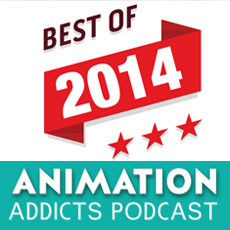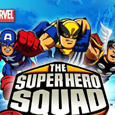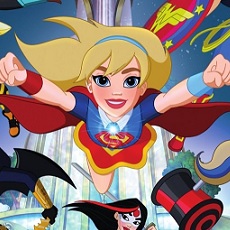Walt Disney Animation Studios (November 7 2014), Walt Disney Home Entertainment (February 24 2015), Blu-ray plus DVD, 102 mins plus supplements, 1080p high-definition 2.39:1 widescreen, DTS-HD Master Audio 7.1, Rated PG, Retail: $39.99
Storyboard:
A computer wunderkind adapts and teams up with his older brother’s robotic creation and his geeky research colleagues to take on a mysterious threat out to control revolutionary nanobot technology which, in the wrong hands, could prove disastrous…
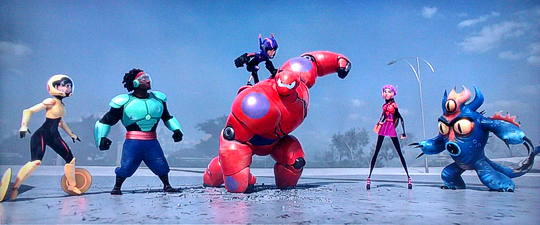
The Sweatbox Review:
Although I have never been able to find any concrete evidence to corroborate this, I once had a book on animation as a child that asserted Paul Terry’s Mighty Mouse character was not simply an obvious and logical cartoonification of Superman, but partly suggested at least by a Walt Disney short that never got past either the initial concept or storyboarding process. Over the years I have seen occasional vague references or mentions of this “Super Mickey” idea (after all, Walt had spoofed King Kong and wasn’t shy about referencing celebrities and films of the day, so it’s not outside the realms of possibilities), but nothing substantial has arisen and it does seem the closest the Disney Studios ever got to transforming one of its classic characters into a superhero originally was with a run of SuperGoof comics and strips (although Mickey Mouse Clubhouse has since run with the superhero concept).
In fact, looking back on the Studio’s output overall, the superhero genre does seem to be a notable omission from its line-up. Over at Warners and MGM during the golden age of animation, such characters as Bugs Bunny, Daffy Duck and even Tom & Jerry were given overtly superhero makeovers or, to a lesser degree, such things as immense strength and other powers for a handful of cartoons. Theatrically, though, that was about as far as it went. Bob Clampett’s 1930s take on the John Carter stories was never realised, robbing us of not only a unique visual interpretation of what might have been cinema’s first “super hero”, but also of where the animated feature medium might have gone in direction before the eventual arrival of Walt’s Snow White And The Seven Dwarfs somewhat set in stone the approach for easily thirty years, if not more, of such pictures to follow.
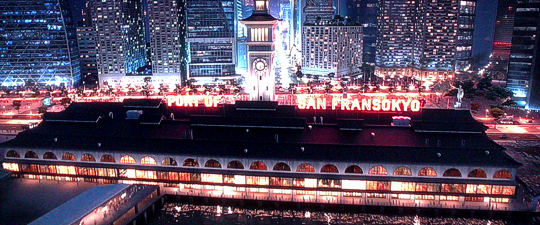
On television, long-running comics series seemed ripe for adaptation, and it’s really been on the small screen where cartoons and comic strip heroes have had most impact, even continuing – and arguably even being boosted – after the huge success of the live-action Superman movie in 1978. If Richard Donner’s film had been the trailblazer, then even so it took a good decade before former animator Tim Burton’s Batman kickstarted the current superhero blockbuster craze: films that, with such a huge amount of computer generated backgrounds, characters and carnage, could somewhat arguably be termed animated themselves, or at the very least hybrid pictures. When Superman Returned, he was little more than the same kind of cartoon that Kirk Alyn morphed into for the flying scenes in his serial outings over 50 years before, while Iron Man’s armor and the Hulk’s hulking presence are down to the wonders of CG motion-capture than any on-set costumes.
Which brings us neatly to Marvel Comics, the independent outfit that found itself sold, merged (with Friz Freleng’s old company) to encompass Saturday morning cartoons as Marvel Entertainment, itself a company that, in its attempts to punch above its weight, ended up licensing some of its prime characters (Spider-Man, the X-Men, the Fantastic Four and initially the Hulk) to other companies, and then seeing those companies make bundles on the respective resulting movies. Finding themselves on the short end of the deal, Marvel established its own studio division, sourcing a series of lesser known characters for what has become known as the Marvel Cinematic Universe, bringing the Hulk – at the time probably their best known entity – back into the fold and leading with a series of films based around Iron Man and Captain America and others, all now huge household names and as part of the grander-scheme Avengers team of movies.

Very early on through that transformation from almost-finished independent comic licensee to blockbuster powerhouse, Marvel was bought lock, stock and barrel by the Disney organisation, in an attempt – since bolstered by its natural companion purchase of LucasFilm and the Star Wars and Indiana Jones properties – to pick up more of a male audience to compliment the largely female-centric audiences the company already enjoyed through its animation films and emphasis on musical fairytales. Marvel brought a hefty weight to Disney, itself getting back on track after some lean years with the outright purchase of their co-production partners at Pixar, and despite some early fan grumbling, the fit seems to be working. Certainly Disney’s deep coffers have been able to let Marvel run free with its ambitious slate and secure distribution as opposed to having to release their films through multiple outlets as before, and now conversely, Disney is able to take advantage of the huge wealth of characters (said to be around 5000) in the Marvel library.
With Spider-Man still at Columbia Pictures (although a new deal will see him pop up in some future Marvel movies) and X-Men and Fantastic Four at Fox, Marvel and Disney are now beginning to move away from the more established characters and starting to really investigate those additional properties: Guardians Of The Galaxy was seen as a huge gamble, as is this summer’s Ant-Man and the announced Doctor Strange and others, although all these eventual outings do have the support of the Cinematic Universe behind them as well as exposure in the wider Avengers network, meaning that audience awareness can be built up in time over multiple movies in order to make them a “must-see”. But what about those characters not destined for the Cinematic Universe? Surely Disney means to mine the Marvel catalog for any and all properties that might bring about new exposure for these little-known comics stars?
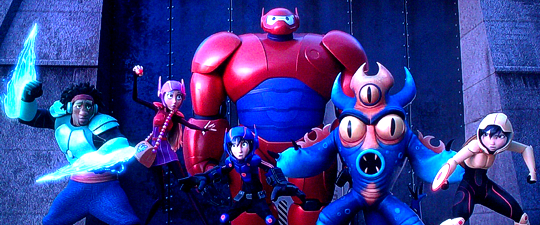
The answer, with a very big bang, comes with the animation unit’s new feature, Big Hero 6, an instant blockbuster if ever there was one. Having bounced back to form with Rapunzel fairytale take Tangled, courted boy fans with videogame extravaganza Wreck-It Ralph and pretty much wowed everyone with last fall’s phenomenon Frozen, the Studio seems to have found a very workable solution in swapping between male and female focused offerings each alternate year, and whatever Frozen had in girl power, Big Hero 6 equals in sheer entertainment value that should just about please all members of its audience, as witnessed by its international commercial success and critical praise too, resulting in its Academy Award win (over DreamWorks’ supposed certainty How To Train Your Dragon 2) just two days before its Blu-ray release hit the stores.
Interestingly, although the film takes its cue from a little-known and limited Marvel comics run, the Studio hasn’t gone the easy way and plastered the Marvel logo on the title, or even shared the credit in a Disney/Marvel way that would have echoed the branding on films from the Pixar division. Given free rein to essentially take the source material but start from scratch, Disney Animation has made the property their own, ostensibly adapting a story to the medium just as they have done countless times before, even if this time the source is a comic book instead of a traditional novel. Indeed, and although the Studio has purchased book rights before (going all the way back to Bambi), the closest I think they’ve come to something like this before was with Tarzan in 1999, where the story and character had to be licensed from the Burroughs Estate. Here, of course, Disney now owns Marvel outright and could, in effect, do whatever they want, but it’s still a rare case of Disney Animation translating a property from another company.
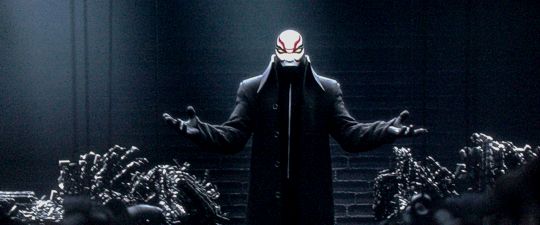
With Marvel’s blessing (and, to all intents and purposes, probably not much in the way of caring too much, since the original run had been mostly forgotten and out of print for years), writer-directors Don Hall (Winnie The Pooh) and Chris Williams (Bolt) have turned the pages into a hugely enjoyable and very visual adventure film, in many ways perhaps the grandest animated movie to come from Disney in the computer age yet. At this point the Studio is thriving, pushing creative and technical boundaries again, just as Walt intended in the golden age and just as the artists did again during the 1990s “renaissance” that saw diversification into stop-motion and computer animation, and Big Hero 6 builds on all that as well as the past few years of innovation, subsequent success and a renewed confidence as a result.
Set in the not-so futuristic but certainly fanciful city of San Fransokyo, where the laid-back atmosphere of San Francisco has been blended culturally and architecturally with the high-tech gloss of Tokyo, Big Hero 6, for all its new freshness and different take in the Disney canon, still feels, as with Wreck-It Ralph before it, part of the same family. The steps taken on such films as Tangled, especially, really come into play here, with spectacular character design, and terrific animation that surely can’t be bettered even though it inevitably will be since I’ve been saying that for the past few films now! The opening shots are simply astounding, quietly confident in their stunning achievement and raising the game for such depictions not only in animated film but for the kinds of CG backgrounds that pepper “live-action” filmmaking nowadays as well. In short, it looks real and, while that’s not particularly the job or goal that animation should achieve, it certainly does set up San Fransokyo and Big Hero 6’s world as somewhere authentic looking and feeling.
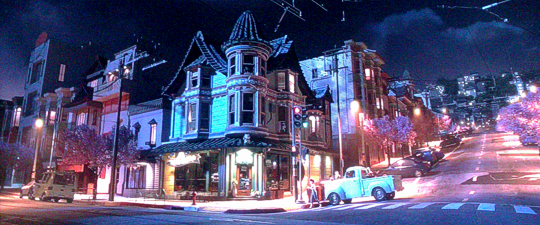
Especially nice are the crowd scenes, now without the cookie-cutter background characters all seemingly based on just a few designs: we meet our hero, Hiro, at a robot wars standoff where he scams the existing champ with his mini-megabot, a convincingly small and ineffective looking ’bot who turns out to be anything but, and the cheering and jeering “extras” are all unique (although I am finding the studio’s female faces, with their small but ski-sloped button noses and super big eyes, are all starting to look the same). This brief moment aside, and remarkably for a modern movie, it doesn’t start with a particularly big whizz-bang, and the choice to go with a whole bunch of support character introductions in a more talky opening is interesting, allowing the story not only to start smaller and grow for real but for the audience to invest in the very human characters before the superheroics begin.
Some of this is a little clunky in the dialogue, especially whenever the inevitable backstory elements need to be addressed, but the performances carry it through. There’s a nice casting touch by having James Cromwell play a robotics genius and, spelling specifics apart, another in-reference gives an opposing character the name Dr Krei, even if it’ll be more obvious to older viewers who the eventual villain may really be. I did find Ryan Potter’s Hiro to be a little old for his character’s supposed age and visual appearance, although I’m equally glad he’s not a whiny kid, and kudos must go to the Studio for backing non-huge names in the primary roles just to give the film some unneeded cred.
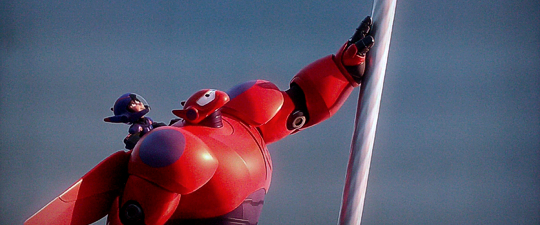
Oddly enough, given how pleased I was with the cast and amazing visuals, it was in the music that I felt the film lacked. Disney’s new go-to composer Henry Jackman’s score follows in the new direction he began with Wreck-It Ralph, and although I largely enjoyed his work here overall, it didn’t feel as fresh as usual, the obvious comparison being Michael Giacchino’s The Incredibles but without the retro pizazz, and sometimes the music here felt it might be better suited to one of the rush of super-TV programs currently playing on small screens everywhere rather than a large feature. Possibly it’s a case of superhero fatigue as well: Jackman is also a seasoned composer of the genre, having taken in Captain America and X-Men movie outings previously, and Big Hero 6 takes a while before a recognisable theme emerges. Even then, there’s nothing spectacularly fanfare-iffic or heroically melodious as even a spoof like Kick-Ass, which also featured Jackman’s music, enjoyed.
That score on this film would have been a perfect blend – and, indeed, I wonder if was used as a temp track during production as there are occasional similarities that go beyond simply sharing the same composer – but here Jackman struggles to compete with himself on the same level, providing as a result a perfectly good score, as expected, though covering old ground. I equally wasn’t too blown away by the much-hyped Fall Out Boy song Immortals, whose lyrics (and even the song’s timing, which seems to just have been used as a source track without any beats for the action to synchronise with) didn’t really fit with what I liked about the characters: that they aren’t super-powered gods and are basically everyday kids – albeit with assumed access to money and tech – in super-suits. The song works great in its end-credit placement, but I wondered if a mega-arranged new version of a certain Bowie song would have been more fitting (this said, I did wonder about the pacing of this montage overall: supposedly in hiding, it strikes me that there’s an awful lot of time passes in R&D mode without the villain bothering anyone!)?
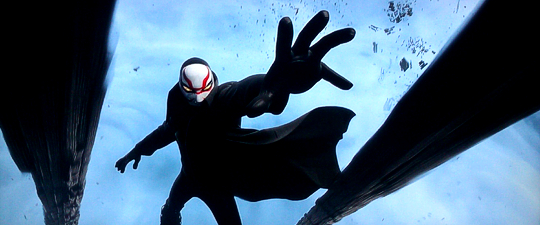
As ostensibly an origin story, the action largely waits out the first half of the film so as to put all the pieces in place for a couple of grand finales, but there’s a lot of humor throughout, including several randomly hilarious touches including a neat Stan Lee “cameo”, a tradition for Marvel-sourced movies…although it’s a joke unfortunately overplayed in the post-credit sting, much as the fanboys may be geeking out. More restraint is shown just when you think another reference can be squeezed in on the cover of several comic books shown, but whereas you may be expecting a certain publisher’s logo in the cover’s corner, you may notice it comes from “DPIX Comics”, for Disney Pictures, instead! Actually, Marvel’s involvement pretty much goes unpublicised: although I had heard of writing collective Man Of Action’s original 1988 Marvel series, I wasn’t at all familiar with it, and so could plug right into this take on the material without any preconceptions or comparisons, and found it to be a vastly enjoyable slice of the new Disney era.
For anyone that does know the comics, one of the big changes comes with Hiro’s super-robot Baymax’s design, going from something more akin to a TransFormer to being ultra-soft and cuddly. I wasn’t always sure about the new approach from a practical perspective: as loveable as he may be, his huge bulk still poses other problems with his primary directive to care (and is as evidenced in the movie), while the placing of an all-important computer chip seems to be in a pretty vulnerable place, and I did chuckle a couple of times when occasional characters’ pronunciation of Baymax’s name sounded like they were recalling a certain home video format that Sony tried to plug in the 1970s! I also felt he resembled some weird pod-like things from the awful Will Smith dud from last summer, After Earth, although a much better and revered slice of sci-fi is evoked in his voice, where a clear inspiration is 2001: A Space Odyssey’s HAL-9000 computer, with an obviously more benevolent and benign version replacing the psychotic processor of that film.

Although occasionally slightly flawed, especially in its mid-section, it’s the little touches, seemingly unique to Disney’s films, that elevates Big Hero 6 to being one of the most broadly enjoyable animated adventure films of recent times, with enough inherent humor to also differentiate itself from the glut of other superhero movies, Marvel or otherwise, even if the target audience is naturally a little younger than usual for those films (and the super-genre in general nowadays). This is what gives Big Hero 6 its fresh take, being something of a return to fun superhero movies rather than the dark, introspective takes that now prevail, even while packing in an emotional enough backstory of its own. It’s here that the Disney touch is most evident, with its protagonist typically struggling to maintain new relationships after losing, one caring aunt aside, his family, and themes of how to cope with loss and the reasoning behind a need to avenge the death of his brother resonating under an otherwise huge, glossy coating.
If there’s one main fault with the story’s construction it’s that Hiro’s supporting characters don’t all get enough development or screentime themselves – the title does reference six heroes after all – but luckily they’re all pretty well sketched out and Freddie and Wasabi especially get enough quips to make sure they land the most impact, leaving the girls to handle the more emotional punches as well as being more than equipped to dish out the physical ones too. The final scenes, as with Wreck-It Ralph, again recall the sacrifice of The Iron Giant, perhaps more obviously given what Baymax is, as does a renewal of the same character. But where the film chooses to go the more routine Marvel route and set up some continuing adventures to come (either by way of a sequel, TV series or, as I actually think would be pretty cool, a run of direct-to-video features to replace the Planes franchise), I think it could have ended very well on Baymax’s final line, a repeat of his boot-up introduction and “Hello Hiro”.
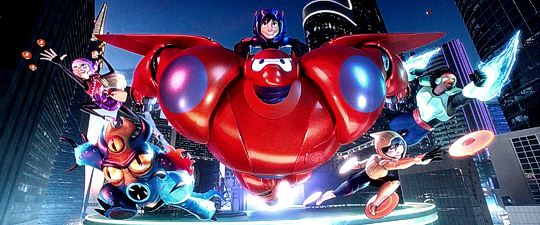
The look on Hiro’s face in this shot says it all, and a cut to the credits there and then would have given us a wonderful Monsters Inc. style closure, suggesting that Baymax is back but not quite revealing him completely, opening up a world of possibilities and allowing for the potential of various visual upgrades for any follow-ups. Instead, the film does go out on a high but it’s a slightly more artificial one than the emotional punch a smaller moment could have provided. Nonetheless, it still puts a playful cap on a super-robust slice of modern animated moviemaking, and it’ll be interesting to see how Disney not only takes advantage of their new Marvel franchise but also if they return to the well to pick out any other properties that could, in theory, begin to build an alternate “Animated Cinematic Universe” of films; a Disney-Marvel-Pixar team-up could see Hiro and Baymax battle classic villains alongside Mr and Mrs Incredible, for instance. The opportunities are exciting and, as the potential start of that, Big Hero 6 is big heroic fun!
Is This Thing Loaded?
Making the disc something of a historic release is the inclusion of the Studio’s latest animated short Feast, the Academy Award winner which gives Disney the unique distinction of being the first time the same studio has taken away both the Best Animated Feature and Best Animated Short Oscars on the same night since the inception of the Feature award in 2001. I’m personally not sure that Feast won on its own merits and wonder if it was not a case of voters seeing the name “Disney” on their ballots and going for the easy option rather than sitting and viewing the other nominees, since The Bigger Picture and, especially, The Dam Keeper have a little more to them, although I am pleased for the Studio; this double-validation confirming that they’re doing the right things while surely cementing their returned to form status.
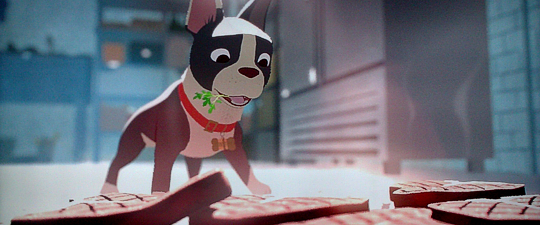
Thankfully, though, Feast itself is a perfectly fine little film in its own right, bringing color to the quasi-hand-drawn-cum-CG look of the studio’s last Oscar winning short Paperman (here dubbed Hyperion Rendering in a nod to Walt’s first studio), although the balance is easily on the CG side of things while any hint of pencil animation is restricted to some of the characters outlines at best. Indeed, it’s not a style that works here as well as it did for Paperman, and little pup Winston comes over more like one of those computer-generated animals from a spate of puppy profiler type games that were a Nintendo DS fad a few years back and popped up on such Platinum Edition DVD titles as Lady And The Tramp and One Hundred And One Dalmatians.
The story, such as it is, follows the young dog’s journey over time via the food he eats – although Feast is better than that sounds – as his owner deals with an on/off relationship all while his and Winston’s diet change as a result. Told through the eyes of Winston himself, Feast joins Disney’s long line of pooch stories, although its simple nature seems more about trying out the visual technique than really trying to engage us in the story. Winston is cute enough, but the overall look feels cold to me, and the somewhat 1950s block-style art approach doesn’t have the warmth usually associated with it, despite how clever it is for the camera to be able to whizz through shots and such.

The Origin Story Of Big Hero 6: Hiro’s Journey takes a more generous than usual 15 minute trip behind the scenes, speaking to director Hall about the translation from comics page to screen (the result purely being Disney’s own take on the material if the hugely different original artwork glimpsed at is anything to go by), and having Go-Go’s voice Jamie Chung host us through the eventual production. How Big Hero 6 fits into the Disney canon is lightly explored (parent-free protagonist, heavy on real relationships) and, although the company is barely name-checked in the credits and was widely known to simply give Disney free reign on the project, Marvel gets in on the discussion too. The origin of Baymax’s face is also touched on, as well as the blending of two major cities to create what was originally termed San Frantokyo. Big Animator 6: The Characters Behind The Characters is a very welcome six-minute roundtable styled discussion between the primary heroes’ artists and the processes they go through to make these movies possible.

Featuring a healthy dose of pre-viz, concept art and production footage, this is an unusual inclusion for a modern Disney disc, but it’s an excellent and genuinely interesting kind of piece that I hope we see much more of on future releases. Despite this inclusion, Disney’s policy of not treating its own animated films to prestigious, bonus packed editions while those from Pixar and Marvel enjoy feature-laden discs otherwise continues here: there’s no commentary track, but we do get the usual bunch of Deleted Scenes with intros by directors Hall and Williams. A Play All option runs the offering of four sequences, all in storyboard form, as a thirteen minute selection, with a narrative alternate opening being too close to other films in the genre, while another opening sets up some later plot points with a little more Bondian intrigue, and although I understand why it was moved, there is a little more clarification here in what is essentially an extended scene. Best of all is the Sinister Six-style grouping of several additional villains in a heist sub-plot…surely the basis of a future adventure?
Another rarity on Disney’s discs, the Big Hero 6 Theatrical Teaser is a welcome addition. Unlike Frozen and many Pixar teasers before it, this doesn’t offer up a ’specially produced sequence but is instead an alternate version of the scene in the movie where Hiro suits up Baymax in his red armor, with orchestral accompaniment rather than the Immortals track. Lastly, there’s a hidden bonus menu Easter Egg about the many hidden Disney references in the movie, from the well-known wanted poster for Frozen’s Hans to a couple of ridiculously hard to spot Hidden Mickeys and a great throwback to Lilo & Stitch! Wrapping up the disc are the usual Sneak Peeks, where Disney Movies Anywhere, the “emotions” teaser for Inside Out, Aladdin’s Diamond Edition, Tinker Bell And The Legend Of The Neverbeast, Disney Infinity, Star Wars Rebels and Clone Wars: The Lost Missions play from the top of the disc or from their own menu option.
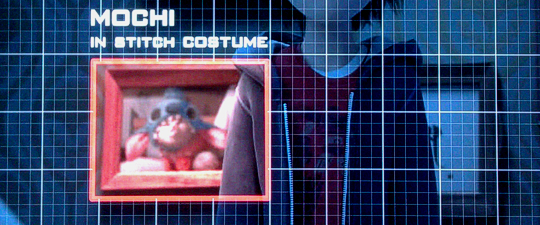
Case Study:
Target stores and the UK release offer limited edition steelbook options (sold out already!) that would suit this particular movie down to the ground, but otherwise you’ll have to make do with a standard Blu-ray case and slipcover, not of the glossy kind but suitably embossed. The cover art isn’t the greatest by any stretch, but it’s adequate, although for once I’d wished Disney would have included a 3D edition of the movie (as it does internationally) since I could see Big Hero 6 being something of a winner in the format. A second disc, an included DVD, is in standard definition, and there’s a code for a digital copy redemption too.
Ink And Paint:
With so many demo moments to choose from, Big Hero 6 is the perfect movie to show off any grand home theater off in style. I was a little apprehensive that the filmmakers had gone for a particularly grainy look given the processing on the disc’s main menu, but this was unfounded as the film is spotless, though I could have done with less of the redundant “dirty lens” effect whenever the camera turns toward a light source – this is an animated movie where there is no camera…and even live-action lenses are cleaned more than this! Other than that, though, ’nuff said!

Scratch Tracks:
While the movie was mixed in the new Dolby Atmos process, and is presented here in a thundering DTS-HD track, it was with the actual sound recording that I had issues during a few points through the film, most specifically some quiet moments when audio background noise was evident on the score, and some filtering was clear on the vocal tracks. This isn’t something I’ve ever experienced with a modern animated film before, especially one coming from Disney, and since they are created in an artificial environment and don’t have the issues surrounding sound being captured live on set, the audio for such films should in theory be perfect, and that it isn’t, especially in this case, was a bit more of a surprise than a disappointment. Some may not even notice this aspect of the mix, and it only occurs less than a handful of times throughout and certainly doesn’t affect the enjoyment of the bigger, more action orientated demo-worthy moments, but it’s an observation worth noting. French and Spanish 5.1 Dolby dubs and subs are also optional.
Final Cut:
With Marvel already in full swing on their Cinematic Universe plans when Disney swooped in to buy the company, Big Hero 6 could honestly be called the first true demonstration of their new owner’s picking of that material and running with it, creating an exceptionally dynamic animated experience that melds their two spheres together, doesn’t sell either side short, and provides audiences and fans with the best of both worlds. While not a part of the MCU itself, it’s possible that Disney could be building towards a secondary animated universe of their own, what with follow-up potential from these six heroes as well as other untapped Marvel properties promising any kinds of combinations down the line.
With such a hit on their hands it’s a shame Disney’s disc isn’t a more stacked affair but then, sadly, they never are nowadays, while Marvel’s own titles, and those of Pixar, regularly enjoy all the bells and whistles. There is a little more than usual to be had here, and although it all packs a lot in, just 40 or so minutes’ worth of supplements isn’t really enough value, even with the added short film. On the flipside, picture is demo perfect and there’s the cache of owning a set that comprises Disney’s historic wins for Best Animated Film and Best Animated Short in one hit, which is unique in itself. With a few more extras this could have been a knockout disc, but as it is it has to rely on the feature to carry it through. Luckily, and I’ll say it again, Big Hero 6 is big heroic fun! Ba-da-la-la-la-la-la!
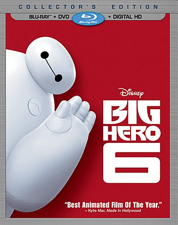 | ||
 |



